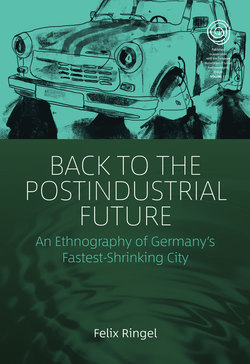Читать книгу Back to the Postindustrial Future - Felix Ringel - Страница 13
На сайте Литреса книга снята с продажи.
Introduction Anthropology and the Future
ОглавлениеNotes from a Shrinking Fieldsite
The future is a flying bullet.
It carries my name and it’s going to hit me no matter what. /
My question is, How shall I catch it? –
With my head, my arse, my hand or with my cheek? /
Does it hit me like a torpedo, or brush me like a kiss?
—Gerhard Gundermann, ‘The Future’1
I started fieldwork in the East German city of Hoyerswerda in 2008. On my arrival, huge excavators were busily tearing down several of the socialist apartment blocks in Hoyerswerda’s New City (subsequently Neustadt). Some used the usual wrecking ball; others deployed enormous forceps, breaking up these formerly five-, six- or eleven-floor buildings piece-by-piece. The piercing sounds of the heavy machines contrasted with the dull noise made by the falling concrete units. When mounting the heaps of rubble left over from what just months before had still been people’s homes, the excavators wobbled like a ship on a sea of concrete, adding a crunching sound to the somewhat eerie situation. Only the water pumps, fighting the dust formation, ran constantly. Once in a while, a former resident would pass by, take pictures and start a chat with the usually smoking operator of the excavator. The latter might have already heard some stories from the lifeworlds he was deconstructing here. He was, however, more eager to answer the not uncommon question of where all the debris would be going when his work is done.
Figure 0.1 Excavator on remains of the ‘PaintBlock’ building, WK 10, winter 2009
The process of the city’s large-scale physical demolition had started exactly ten years earlier in 1998. That same year, the local singer-songwriter Gerhard Gundermannn performed a song, ‘The Future’, for the last time. In this song, whose first lines open this Introduction, Gundermann describes the future as a ‘flying bullet’, which carries his name and is going to hit him ‘no matter what’. In Hoyerswerda, which would later in 2009 be officially labelled Germany’s fastest-shrinking city, the future indeed appeared to relentlessly bring its demise. However, Gundermann adds a twist to his deterministic, hopeless characterization of the future as a flying bullet: ‘My question is, How shall I catch it?’ Instead of giving in to the inevitable flow of time, he claims that we have the power to relate to the future in our own ways: we can – arguably – determine whether this future is to hit us ‘like a torpedo’ or brush us ‘like a kiss’.
For the urban community of a shrinking city, the future poses an ongoing problem. This monograph explores the ways in which inhabitants of Hoyerswerda relate to their oncoming futures and shows how their experiences of shrinkage can help anthropology as a discipline to properly constitute the future as an integral part of its analysis. In the following sections, I will first introduce my fieldsite and then sketch my vision of the anthropology of the future, continuing an old tradition in the anthropology of time by taking inspiration from recent philosophical work on metaphysics. Having linked ‘ethnographic’ to ‘metaphysical’ presentism, I show how in Hoyerswerda the future has been rendered problematic and how it has become an epistemic object in its own right – for both my informants and myself – in the third section. In the last two sections, I proceed by conceptualizing knowledge and time in relation to one another I close by reviewing my overall argument. This book’s general aim is to provide the reader with an ethnography of hope and the future in a city that, for many, was doomed to have neither of those. However, I read this city’s present not through the lens of its (failed) past(s) – socialist or postsocialist – but from the perspective of what my informants considered a much more pressing concern: their personal and collective futures.
